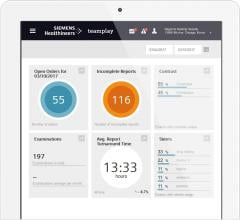
Analytics applications can help healthcare providers transform data into actionable insight, and to make quicker, more informed decisions to improve clinical, financial and operational outcomes.
Analytics in the past couple years have moved far beyond the simple dashboards used by many cardiology department administrators to dedicated, complex, powerful data mining and interpretation software. Patient data is increasingly concentrated in the electronic medical record (EMR). More data is now collected by the diagnostic testing systems and imaging equipment. Department, hospital and healthcare system data on billing, patient throughput, scheduling, inventory and expenses are tallied electronically. These data offer new tools for department directors to improve efficiency.
Vendors have introduced increasingly sophisticated analytics software platforms to mine these data. Analytics software was one of the top trends seen at the 2016 meetings for the Healthcare Information and Management Systems Society (HIMSS), the American College of Cardiology (ACC) and the Radiological Society of North America (RSNA). This includes pulling information to improve department or hospital management, quality assurance to boost outcomes and efficiency, and even the ability to identify patients who are ideal referrals for new clinical programs.
Most healthcare systems are refocusing information technology (IT) efforts on the implementation of advanced analytics software now that EMR implementations required under the initial phases of healthcare reform are complete. Providers are shifting resources from the EMR implementation to analytics and population health to fully leverage the new investments in data aggregation, said Jonathan Niloff, M.D., vice president and CMO of McKesson’s connected care and analytics division. He said today’s analytical software is much more sophisticated than in the past, where all data points from the EMR and interconnected IT systems can now be searched in one location.
Basic analytics data has been available for years but required time-consuming, manual tabulation of data points. Dashboarding features to automatically track specific data have been around for several years to offer an overview of key departmental statistics. Over the past year, there has been a wave of new and much more sophisticated analytics software packages released on the market. These are no longer tied to pulling data from one vendor’s IT system, but operate as a third-party software with the ability to pull data from numerous data sources, including not only the EMR but patient reporting systems, picture archiving and communication systems (PACS), cardiology information systems, admission, discharge and transfer (ADT), medical coding and billing systems, inventory management and lab reports. These systems also offer data beyond traditional software systems, tapping into the raw data of diagnostic modalities and ancillary devices themselves, including computed tomography (CT), digital X-ray, angiography and automated contrast injectors. This data can be leveraged to identify trends in usage, contrast dose by procedure or protocol, and radiation doses used.
As interoperability between data and imaging systems has improved, analytical software can now perform more complex data mining, such as reviews of imaging radiation dose levels by patient, by protocol or modality. Outliers in these reports can be clicked on to drill down data to see which machine that exam was performed on, the tech who performed the exam, or look at the specific patient’s EMR data to see if they are extremely obese or if there are other reasons that required a higher X-ray dose. If a particular machine or technologist is suspected of having quality issues, the newer analytics systems can pull historical data for a particular machine or technologist to see if there are other outlier exams, which may identify staff that need additional training or older equipment that needs to be replaced.
New analytics software can pull data from operating room or cath lab procedures to track average procedure time and the costs of the procedure by CPT code, types of procedures, disease state, specific physicians or specific implantable devices.
Business uses include better management of inventory, procedural room use, imaging utilization, staff performance, radiation dose management, monitoring factors for patient satisfaction and to help identify bottlenecks in patient discharge, door-to-balloon times, STAT radiology reads, and what contributes to poor or improved patient outcomes. This data has been available for years at many facilities, but it is the new level of analytics software integration that now makes data mining possible for all these things on one screen using one program.
Read the related article “Analytics: The Next Big Health IT Undertaking.”
New Analytics Software Integration
Analytics fits nicely with the current trend in the healthcare IT world toward enterprise IT platforms where all departments can aggregate their data on one vender neutral archive (VNA) or other type of central database. This centralization can greatly aid the value of analytics because it offers a much more complete picture of not only patient histories, but also data based on billing data, coding, physician or other staff workloads, the flow of patients through departments based on scheduling, turnaround times on reports, and other facets of both patient care and business administration.
“Clinical, financial and operational data from all departments across a health system must be integrated and available for the personalization that builds trust with physicians and staff”, said Parag Paranjpe, founder and CEO of the healthcare analytics company HealthLevel. “We find this level of integration, combined with data transparency, to be key components for driving the meaningful staff engagement that can significantly improve patient care, clinical quality and business performance.”
Among the biggest of the big-data analytics software releases have been from GE Healthcare and Siemens at RSNA 2015 and Philips Healthcare at RSNA 2016. These illustrate the new breed of analytics software being released by numerous vendors today, both large and small. The systems developed by these three vendors created a common, vendor-neutral analytics platform that can operate on both their information systems and those of other vendors. These platforms can be sold separately or integrated as a third-party software system. They all sit on top of the EMR, ADT, PACS, cardiovascular information system (CVIS), and other hospital and patient reporting systems. With a big focus now on enterprise IT systems, all three vendors say their platforms act as an integration engine for all the -ologies across the healthcare enterprise.
From a cardiology perspective, GE’s system, part of the new GE Cloud product, can pull up inventory management system data and link disposables and implantable device usage to specific costs, procedures, procedure types, specific physicians, drugs used, expenditures to date and show where specific items are located in departments. The software can also pull data by physician, procedure type, procedure stats based on patients’ risk scores, length of stay or disease states. Specific outlier patients can easily be identified and data specific to these cases pulled for review.
Watch a video explaining how analytics can help improve workflows.
Analytics Software Comparison Chart
This article served as an introduction for a comparison chart of software from several IT vendors in the cardiology and radiology space. To access the chart, go to www.dicardiology.com/content/analytics-software. This will require a login, but it is free and only takes a moment.
Vendor on the chart include:
Carestream
www.carestream.com
GE Healthcare
www.gehealthcare.com
HealthLevel
www.healthlevel.com
Lumedx
www.lumedx.com
McKesson
www.mckesson.com
Merge/IBM
www.merge.com
Novarad
www.novarad.net
Philips
www.usa.philips.com/healthcare
Siemens
www/usa.siemens.com/CVIS



 February 15, 2022
February 15, 2022 








